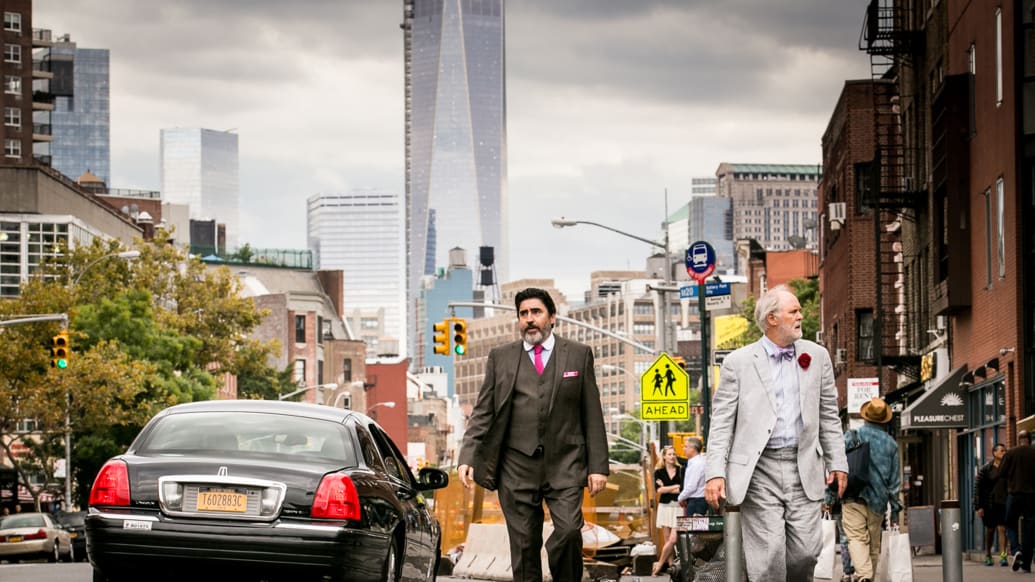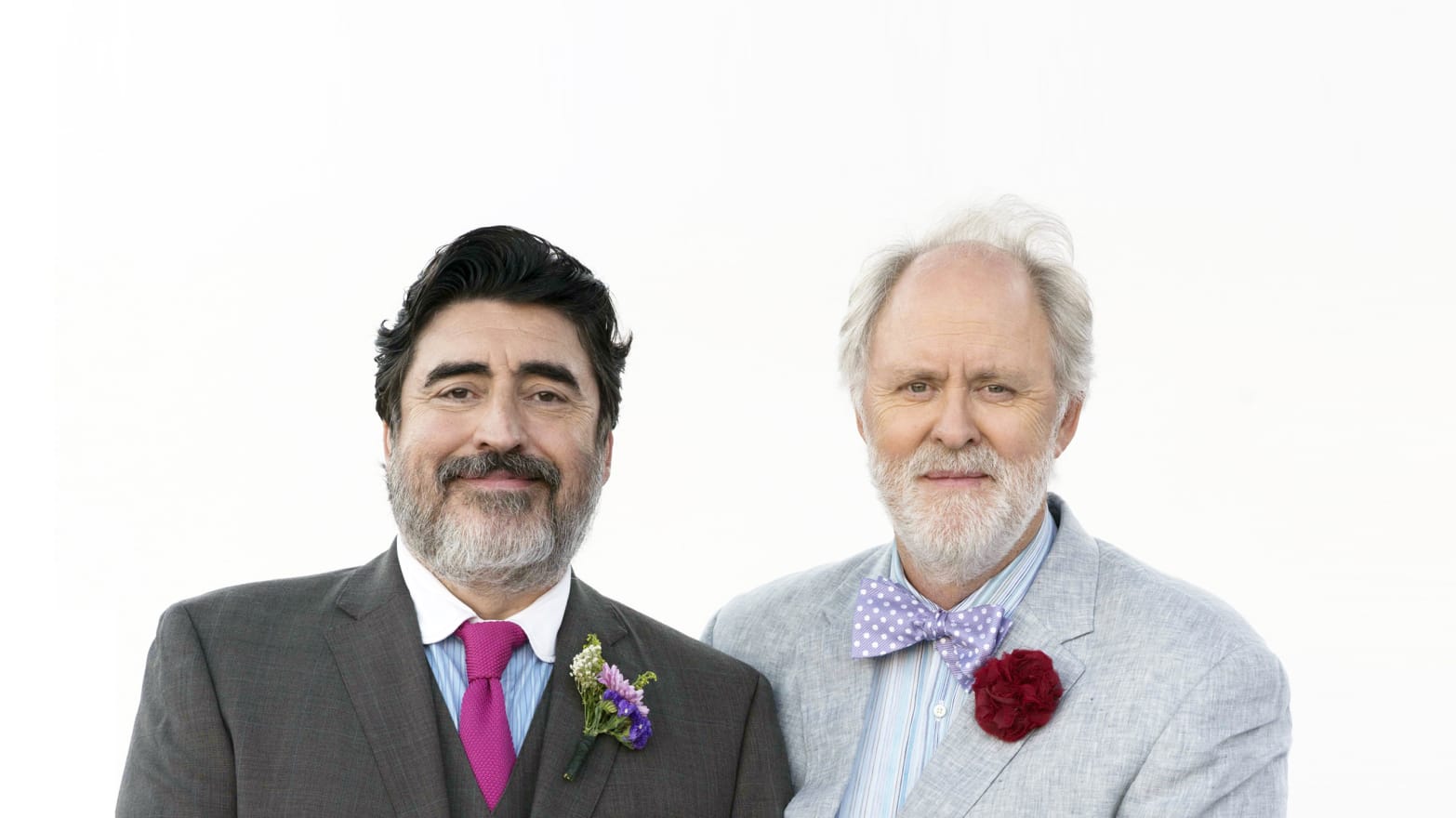It almost feels sacrilegious—and maybe even a little bit gross—to call Love Is Strange profound, or important, or a painfully necessary film.
An achingly beautiful chamber piece about an older gay couple whose lives are upended by financial downturn, Love Is Strange is remarkable because of an insistence on not making its headline-grabbing and boundary-pushing elements—this is the story of a same-sex relationship set against the backdrop of the legalization of same-sex marriage—seem remarkable at all.
In fact, played with all the lived-in heart, soul, affection, and hostility of a couple that’s been together for decades, the story of George (Alfred Molina) and Ben (John Lithgow) could very well be called Love Is Normal.
“It’s a story about a relationship and the fact that they’re gay men, in a way, is almost irrelevant,” Molina tells me, a sentiment that’s certainly echoed by his co-star. “It’s just a beautiful portrait of love, taking the sexual part out of it,” Lithgow says. That matter-of-factness is what makes the film so great—and the circumstances behind its bleak narrative so infuriating and timely.

Boiled down to a simple review, Love Is Strange may be cinema’s love story of the year. But after you’ve had time for the film to settle with you—all of the hope it portrays about love in a modern world along with all the hopelessness of things that are beyond our control—it becomes clear that this could be the human story of the year, too.
Not that the movie overtly pursues either of those superlatives.
“What impressed me about the script is the fact that it wasn’t polemic in any way,” Molina says. “It wasn’t agitprop in any way. It was just the story of a relationship, and an examination of how even after all those years together, one event can have a catastrophic effect on things. And that is gay or straight.”
When Love Is Strange begins, George and Ben are waking up next to each other, as they have for 39 years. They shower, dress, bicker, chide each other about being late, tell the other where his glasses are, tie the other’s tie, and hurry each other out of their gorgeous New York City apartment, lest they be late. “The best compliment I received about the movie was that somebody said, ‘You and John look so fucking married,’” Molina laughs. And they do. They look so fucking married.
But minutes later, in a particularly sweet revelation, it dawns on the audience where they are rushing off to. It’s this so-fucking-married couple’s wedding day. Gay marriage had just passed in New York and, after almost four decades of being committed to each other, George and Ben are finally making their union legally recognized.
Soon their apartment is filled with friends and family tipsily toasting their marriage and paying tribute to their example of a loving relationship. But the bliss of the day—and the film to that point—soon halts abruptly.
George is a choir director at a Catholic school, where, even though the entire staff and student body knows he’s gay and has been with Ben for almost 40 years, he is fired for getting legally married to a man, an act which violates the church-sanctioned moral code.
What starts as bittersweet—one of the happiest days of their relationship directly leads to one of the most tragic—becomes aggressively grim as George and Ben are forced to sell their apartment, get screwed over in the transaction, and are unable to find an affordable place to move into. Just weeks after their legal union, they are forced to separate, physically.
The two have no other recourse but to seek out the kindness of the people who had just been toasting them at the apartment they are now evacuating. George moves in with a young gay couple, friends of theirs, who live downstairs and Ben is taken in by George’s nephew and his wife, where he shares bunk beds with the couple’s teenage son. Indignity and awkwardness abound as George and Ben are forced to swallow generous amounts of pride each day with their pills in order to make the living arrangements work, while their respective hosts grow increasingly weary of having chatty interlopers inserted into their settled home lives.
It’s a sequence of startling events, made all the more startling by George and Ben’s grace through it all, and their lack of bitterness.
“Nobody was saying, ‘Goddammit, this isn’t fair!’” Lithgow says. “There’s this sense of, ‘OK, let’s move on to the next.’ Because those are the circumstances they’ve been living under for 40 years.”
The tricky balance struck between the starkness of George and Ben’s situation and the emotional richness of their relationship has become a signature of sorts for Love Is Strange’s director Ira Sachs, who has made a name for himself with unflinching and unflinchingly romantic queer films, particularly the 2012 indie hit Keep the Lights On.
“He’s made several gay-themed films that are full of a lot of agony and torment,” Lithgow says. With Love Is Strange and the relationship between Ben and George, he had “literally set out to do a positive look at his own future.” Sachs had recently gotten married himself, Lithgow says, and “wanted to project into the future what a long lasting, committed relationship would look like.”
After watching Love Is Strange, one would hope that it would look like George and Ben’s.
Originally, the role of Ben had been slotted for British thesp Michael Gambon, who was forced to pull out because of scheduling conflicts. Molina was already attached to the film, and was nearly ecstatic that it was his old friend John Lithgow who was in talks to play his hubby.
The two had met in passing in the ’90s on the red carpet for a theater event, and stayed the kind of friends who wave at each other across crowded rooms. “We’re both theater rats,” Molina says. “I tease John that the first thing we have in common is that neither of us have ever met a piece of scenery that we didn’t want to chew.” Their friendship deepened years later when they would encounter each other at the hospital when visiting their mutual friend Ileen Getz, who was in the last throes of her battle with cancer.
“I’m not sure if I can specify how exactly our friendship informed our work,” Molina says. “But I know it did. It certainly made those intimate scenes much easier, because there is a genuine affection between us. So having to cry and fall into his arms and lie in bed, we were able to dive in without having to introduce ourselves to each other.”
And while, as said before, we’re cautious to label a film that deals with its characters’ gayness so matter-of-factly as “remarkable,” so as to not betray that very achievement, it’s in those more intimate scenes that Love Is Strange may be at its most astounding.
So often when a film is made about a gay romance, the characters are young and promiscuous, or young and questioning, or young and in love, or young and trying to find themselves and their place in the world. Mostly, though, they are young.
But when George climbs into bed with Ben midway through the film and the two characters just hold each other, with all the comfort and feeling of men who have been in love for 40 years, it was a portrayal of a gay relationship that I don’t think I had ever seen before on screen. I can’t think of another example of older, settled gay film characters long into their lives that young gay people could look at and think, “One day I hope that my partner and I will be like that, like them.”
For all of the progress in depicting modern gay relationships in film now, there has never been one for people to aspire to in the future. We’ve seen men meet the men they want to grow old with, but we’ve never seen what it’s like when they actually get old. More importantly, that they can be happy. “It’s amazing how you can give people the shock of the new by showing just that,” Lithgow says. “In fact, it’s intensely moving, the fact that, at that moment, you’re seeing something that really is so ordinary for the first time.”
The film, as maybe shouldn’t come as a surprise, isn’t just intensely moving for audiences to watch, but was for Lithgow and Molina to shoot—particularly as a real-life example of all that George and Ben have endured was right in front of them throughout filming.
The scenes set at George and Ben’s apartment were filmed in the home of a gay couple in their 80s, friends of Sachs’s who lived in Jackson Heights, Queens. The couple charmed the actors instantly, presenting them with all the Playbills from every single Broadway production they had ever starred in to sign. But their impression loomed larger than just polite fandom.
“You look at a couple like that and realize that they’d been together for maybe 40 or 50 years in a society that regards them as second-class citizens,” Lithgow says. “And in order for them to stay together, just be with the person they love, they’ve had to more or less live with that and accept it, and be grateful for what they get in return, which is intimacy with each other.” Lithgow’s next observation is one that had a shattering effect on both actors: “But, if they walk down the street with each other, they don’t touch. They don’t hold hands.”
Near the end of Love Is Strange, George and Ben exit a bar drunk and drunk on affection for each other and walk down the street side by side, but, like the couple from Jackson Heights, never make physical contact with each other as they stroll. They don’t hold hands.
“I remember thinking that, as a straight man, the thought of walking down the street with someone I love and not holding their hand or be able to link arms or feel easy about putting my arm around them—I can’t even imagine how that feels,” Molina says. “So to be able to live with that and still be able to make a relationship work and still have value and meaning is extraordinary to me.”
It’s when the discussion turns further to gay couples in real life who have had profound effects on Molina and Lithgow, and the possibility of this film in turn having some effect on those couples’ futures, that both actors become visibly emotional, tearing up and choking on their words as they speak.
Recalling a post-screening Q&A at Sundance after which one audience member stood and said, “I’ve been with my partner for 35 years and thank you for validating everything we’ve felt and we’ve been through,” Molina says he got chills remembering the standing ovation the man received. “It was an extraordinary moment,” he says. “It’s hard not to get emotional about this because I’m so proud of this film.”
For both stars, though, it’s the same-sex weddings they’ve been to that bring out the waterworks. “There’s something charged about it, because it’s so hard won,” Molina says. “I’m a bit of a crybaby. I cry at weddings. When you see what some people have had to go through to get there, it just adds to the power of the moment.”
Lithgow had attended his first gay wedding ceremony just one year prior to our talk, and practically wept while recalling the speech that one of the grooms gave at the altar. “He spoke about how he had had to live with shame all his life and that Chris, his husband, was the first person who relieved him of shame,” Lithgow says, tears in his eyes. “Even telling you that story chokes me up so much. You hear very moving words spoken at a wedding ceremony, but not like that. I’ve never seen that kind of intensity and emotion.”
After premiering at Sundance this winter and playing at several other film festivals since, the film has received a rapturous reception from moved audiences, particularly those with ties to the gay community. “I always knew it was going to be really, really fine,” Lithgow tells me about this quiet little indie, made for just over $1 million with only 27 days of shooting.
“I knew Fred and I would be a great pairing. During the shooting, every decision was a good decision. So I knew it was going to be very fine.” Then he pauses and looks up, doing a quick bout of surveying in his head. “I didn’t know it would be so embraced,” he says. “It seems like it’s just possible that it will be quite a revolutionary film.”
If it is, and it should be, well, that wouldn’t be strange at all.

